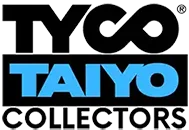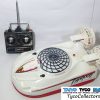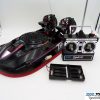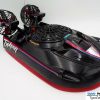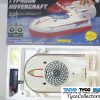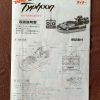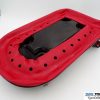The Taiyo Typhoon Hovercraft is a radio control hovercraft manufactured by Taiyo of Japan, and released into various European markets, and other countries worldwide in 1988. It's the English language version of the original 1988 Taiyo Typhoon (Japan).

Performance
With 2 x Mabuchi RK370 motors, the largest ever in use by Taiyo, the rear fans were powerful. However, as anyone who has piloted a hovercraft knows, without any attachment to the ground (you're floating on air) there's no such thing as brakes and control over direction is difficult - much like driving on ice, with so much momentum it makes sharp turns impossible.


An instant hit
First Released in 1988, the Taiyo Typhoon Hovercraft was an instant success, quickly selling out of inventory, and eventually becoming one of Taiyo's flagship products, creating sales that Taiyo hadn't seen since their earlier hit, the 1986 Jet Hopper.
Do you have one 'Made in Japan'?
Both the Global and Japanese market models were Made in Singapore, which is unusual for Taiyo, who would always manufacture Japanese market variants Made in Japan. This suggests demand was so high, it required two factories to fulfill orders. Do you have an original Made in Japan Typhoon? It may be rarer than you think! Comment below!
Acclaim
The product was so well received, it was awarded the Tokyo Governor's Award at the 1989 Tokyo Toy Show.
On the Japanese release, a golden sticker was placed on the front of the box to mark the occasion.

Further models
As expected, Taiyo took advantage of its popularity and over the next decade launched many spin-offs:
- Mini Typhoon
- Super Typhoon
- Jet Typhoon
- Typhoon 2
- Typhoon T-3
- Typhoon T-4
Do alkaline batteries damage the Typhoon?
During our research, we came across some European model Typhoons with a sticker on the front "Use only Ni-Cd batteries". Nickel-cadmium AA batteries are 1.2v rechargeable, and so 8xAA = 9.6V. However it's always been common for people to use regular 1.5v non-rechargeable batteries, which gives us 8xAA = 12V. Turbo Power! So does the Typhoon have an issue with this? Maybe. It's the only model that has its motor constantly running at the highest speed (the central 'compressor' fan), so its possible this becomes overheated and the brushes on the motor wear faster than usual, and no more hovercraft. There's extra credence to this theory when you consider that Taiyo and Tyco introduced heat sinks to all their high powered 9.6V models, to reduce wear created by constant high speed running.
